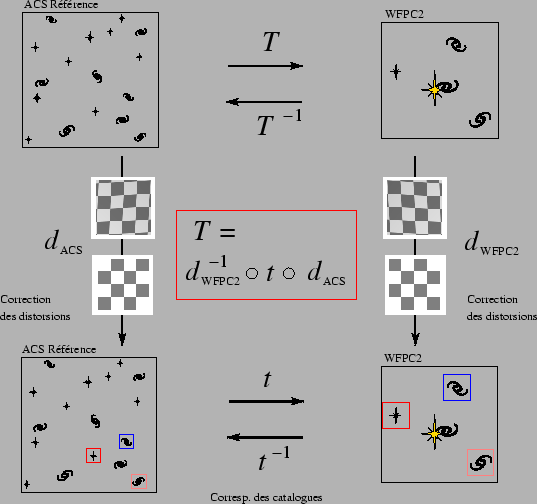The quality of pointed between images ACS and WFPC2 does not make it possible to make an alignment with the precision necessary to make subtractions of images. The WCS makes it possible in practice to align the images with a precision limited to 5 pixels. We must thus have recourse to the objects present in the two fields to make the alignment of the images.
The principal difficulty of this stage comes owing to the fact that the field of Planetary Camera is very small (![]() on side). The images in general present only very few objects (ten on
average). The majority of these objects are galaxies of weak
luminosity. In the best of the cases, we have one or two stars.
Moreover, the rejections the cosmic ones are not effective at 100%.
There remain often residuals of coincidences the cosmic ones on the
image. This makes any automatic control of objects hazardous. It is
thus not possible to detect the objects in an automatic way.
on side). The images in general present only very few objects (ten on
average). The majority of these objects are galaxies of weak
luminosity. In the best of the cases, we have one or two stars.
Moreover, the rejections the cosmic ones are not effective at 100%.
There remain often residuals of coincidences the cosmic ones on the
image. This makes any automatic control of objects hazardous. It is
thus not possible to detect the objects in an automatic way.
We thus decided to build the lists of objects to the hand by comparing with the eye all the images of follow-up of each supernova. This enabled us to build lists from 5 to 15 objects used to make alignment. Each object present on an image of follow-up was thus associated the same object on the image of reference. We thus built lists of pairs of objects for all the images of follow-up.
As we saw, the images of cameras ACS and, to a lesser extent, WFPC2, display significant geometrical distorsions. They are modelled by transformations of order 3, it is thus impossible to correctly determine the transformations to align images WFPC2 of follow-up and images ACS of reference by using the lists of pairs which we built.
However, the geometrical distortions of the images are relatively well-known. The successive observations of globular clusters with the pointed different ones made it possible to build models of these distortions . We thus used these transformations to correct the distortions of the two images.
Our goal being to bring the images of reference on the images of follow-up, we proceeded as follows:
Figure 8.16 summarizes the method employed for alignment of the images of reference.
 |
The images provided by STScI for ACS are of two kinds, the summoned images for which the cosmic ones were eliminated, these images corrected for the distortions.
The correction for the distortions requires a rééchantillonnage images, which degrades the quality of the images and introduced significant correlations between the pixels. We used the images not corrected for the distortions which did not undergo a rééchantillonnage.
To avoid the successive rééchantillonnages the procedure which is applied to them during the alignment of the images comprises only one single transformation of the images. We checked that our procedures of correction of the distortions gave the same images well as the procedures used by people of STScI.
This procedure enabled us to align the images with a precision about some tenth of pixel. We will see in the continuation, that this precision is not however sufficient to allow a differential photometry directly on the pixels.
The second stage of alignment, is photometric alignment. Indeed, the images of follow-up and reference have exposure times and an effectiveness of different detection, it is thus necessary to standardize the image of reference to bring fluxes of the objects on the two images to the same level.